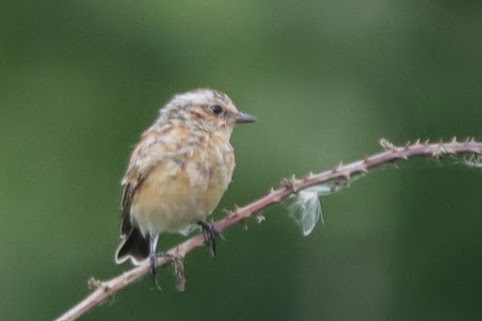Although I chose to spend the weekend watching sport, the lionesses roar being too loud to ignore, Morton Bagot was not far from my mind and I felt compelled to pay it a visit this morning. Apart from anything else, the World Cup defeat was a bit of a downer, so I needed a pick-me-up.
I enjoy documenting what I see with photographs but would always describe myself as a birder first and foremost. This has the disadvantage, for this blog, that when I do see something noteworthy my first reaction is to look at it properly, and only then do I reach for the camera.
This is a roundabout way of admitting that I had an excellent view of first a Spotted Flycatcher and then a Grasshopper Warbler, without being able to get a shot of either. The flycatcher flew into a small plantation next to the ringers' favoured spot and perched up slightly obscured by leaves before flying out of view, while the Gropper flew up from long grass into a small bush in the Chat Field before edging to the other side of said bush and then flying into a hedge where it disappeared.
There was at least one bird I knew I would get a shot of, if it was still here. John C had found a Greenshank on the flash field on Saturday and I was optimistic that it would stick. And sure enough it had.
 |
| Greenshank and Green Sandpiper |
The nearest flash continues to look excellent, and I was joined in the gallery by Dennis and Marion S. The farmer unwittingly benefitted us by driving his quad-bike around the field flushing the contents of the furthest flash onto the nearest. We were thus able to count 40 Teal, two Shovelers, and a Little Egret which may otherwise have been out of sight.
 |
| Two eclipse drake Shovelers (and Teal) |
The Green Sandpiper count was just three, and Lapwings were on 24, suggesting that others remained unseen.
The rest of the morning was just a matter of searching the bushes for warblers and their ilk.
 |
| Lesser Whitethroat |
 |
| Common Whitethroat |
As for insects, I noticed quite a few Small Heath butterflies on the wing which suggests a new summer brood, and several Brown Hawkers and Southern Hawkers none of which posed.
 |
| Juv Whinchat moulting into 1st winter - per Dennis Stinton |
This is quite an unusual plumage to see in the Midlands. Like Stonechats they can migrate before they fully moult their head, mantle and breast feathers. I would love to know where it came from.
No comments:
Post a Comment